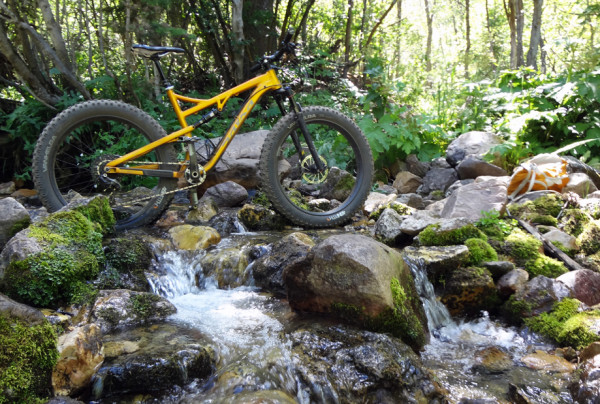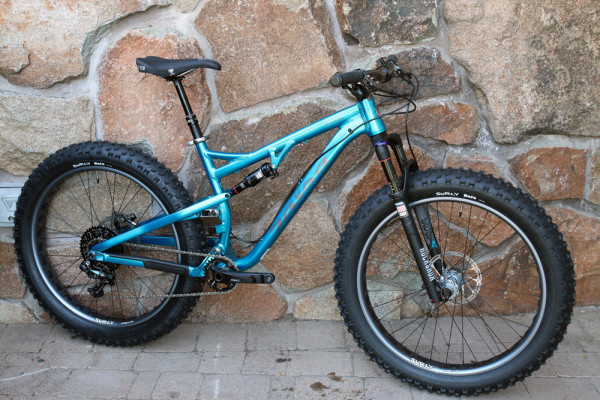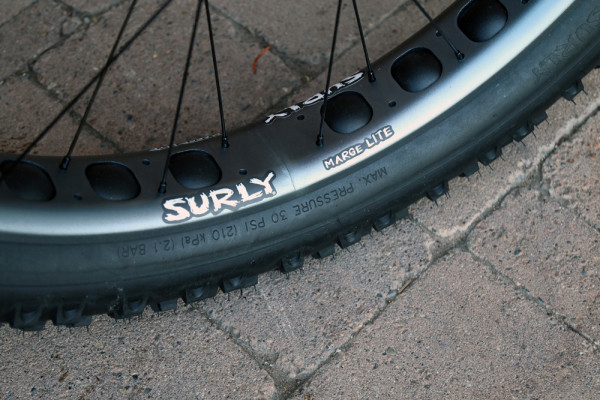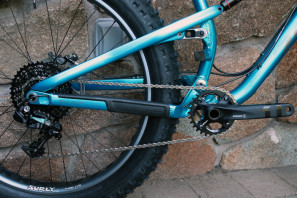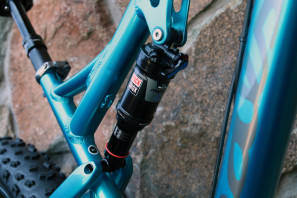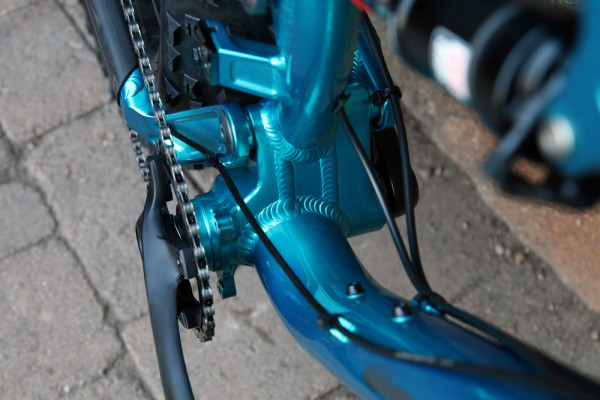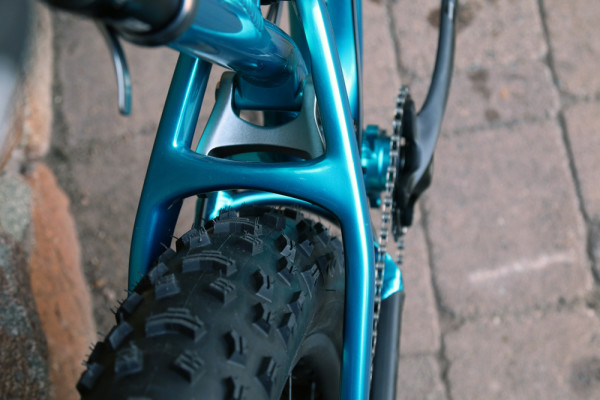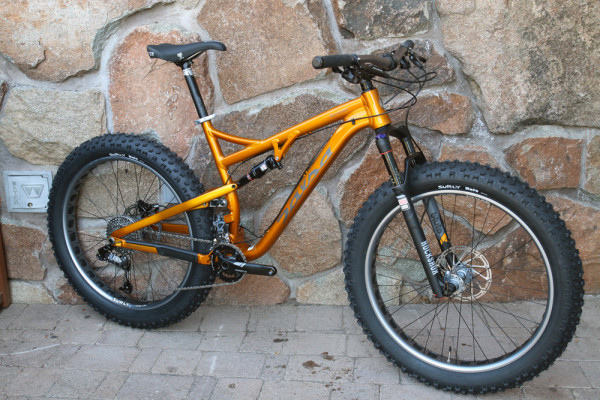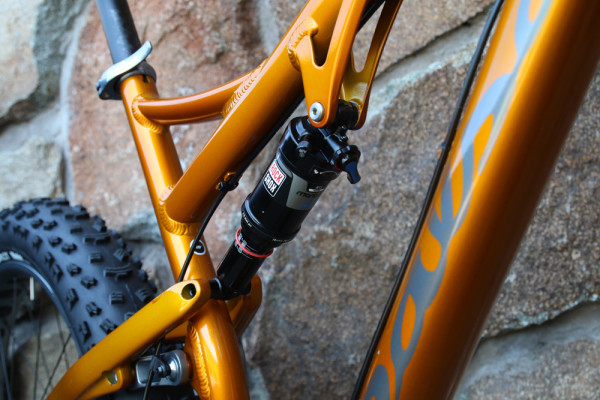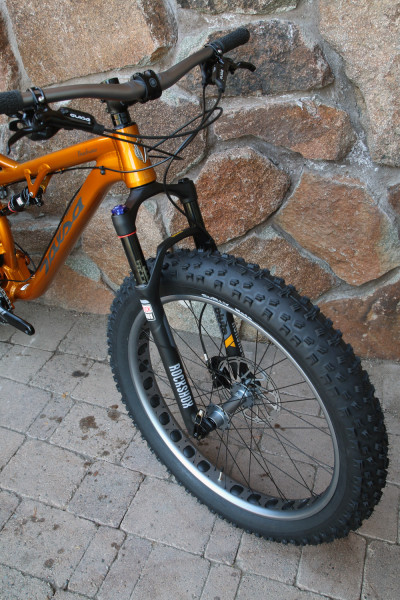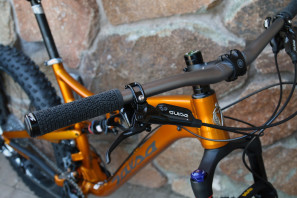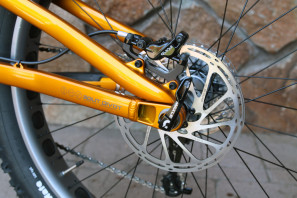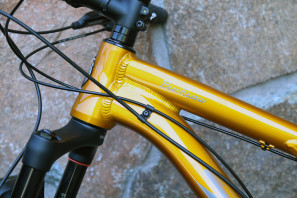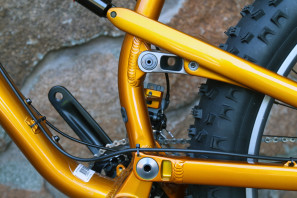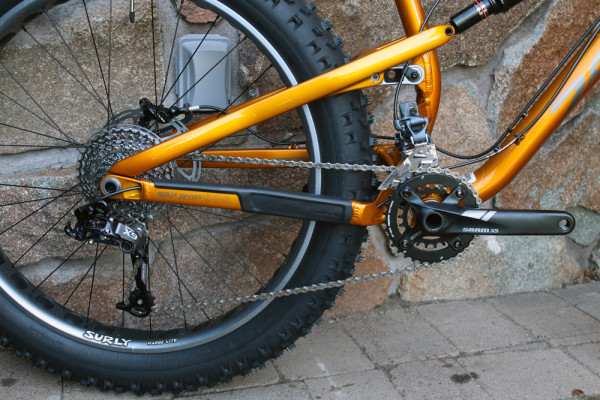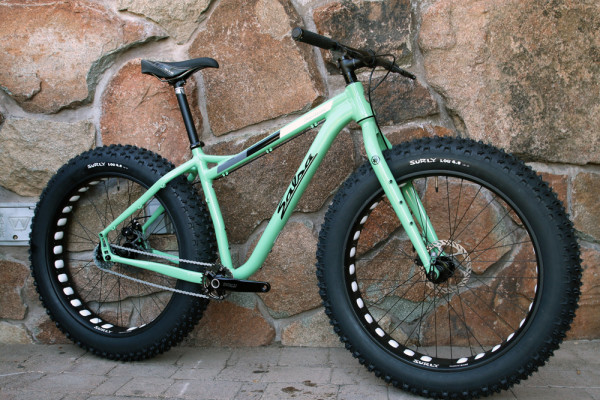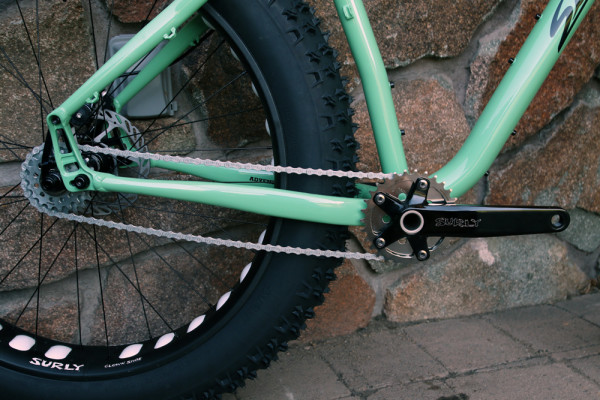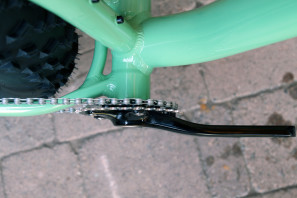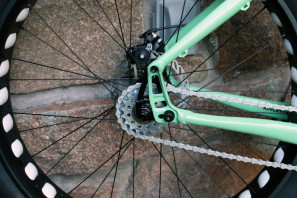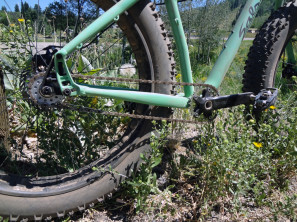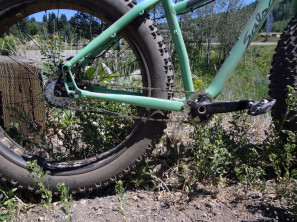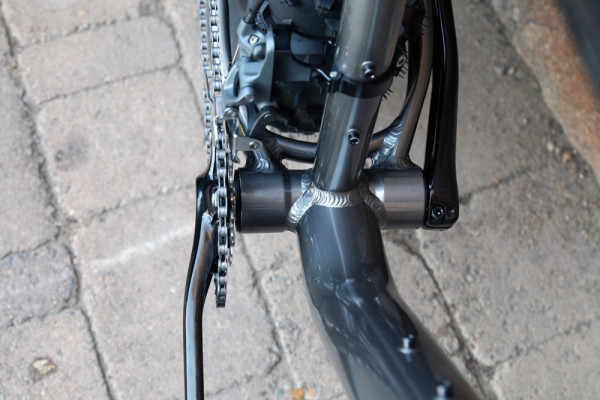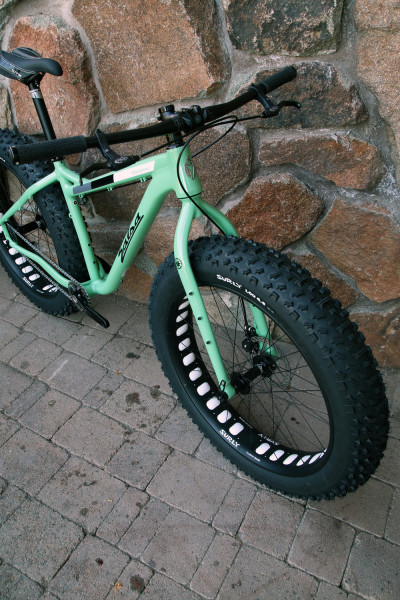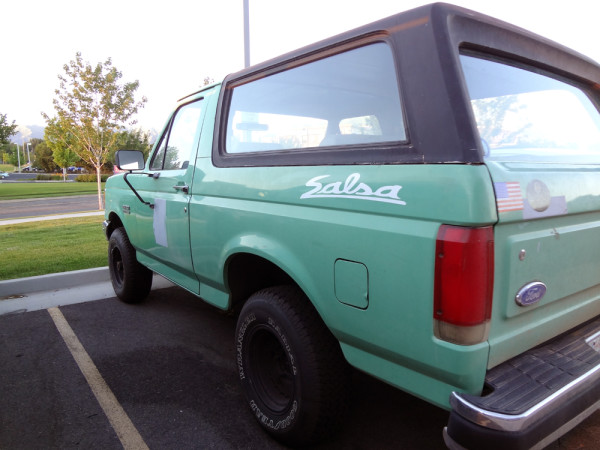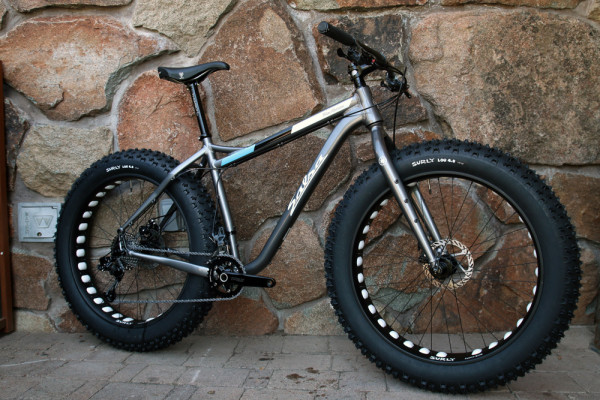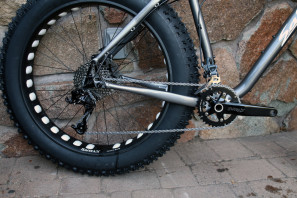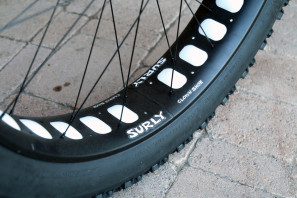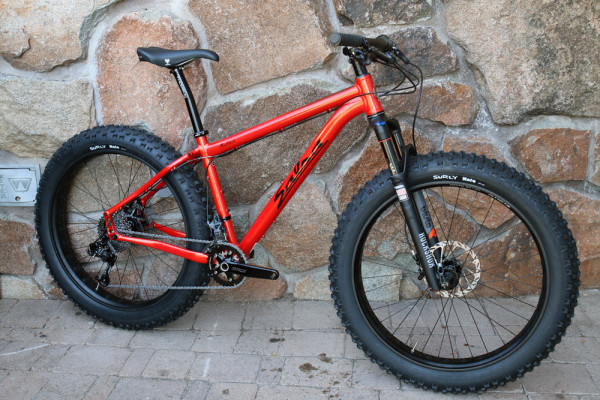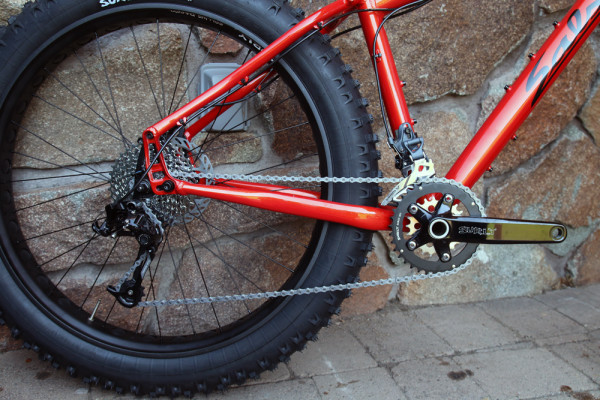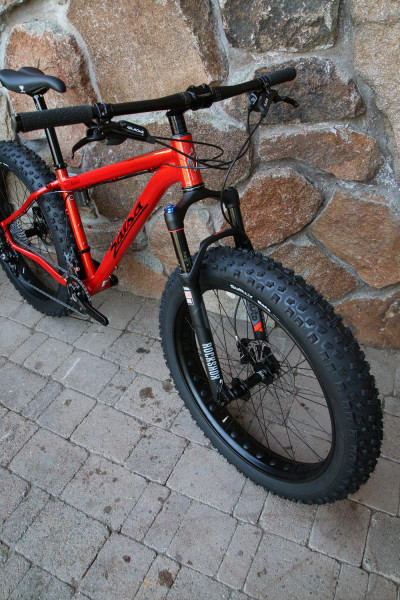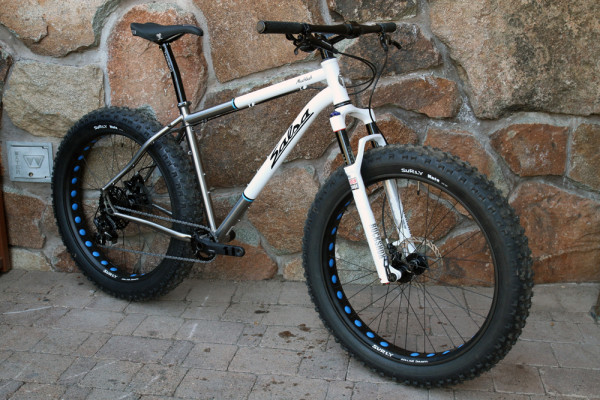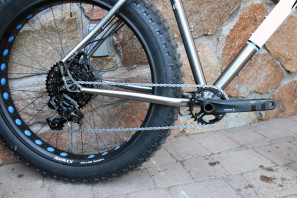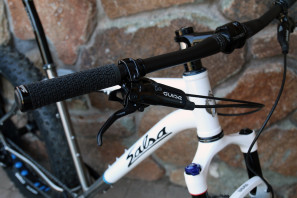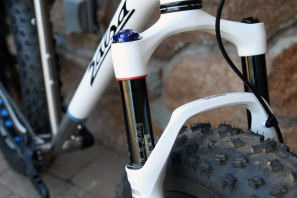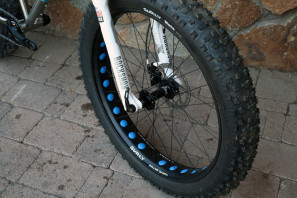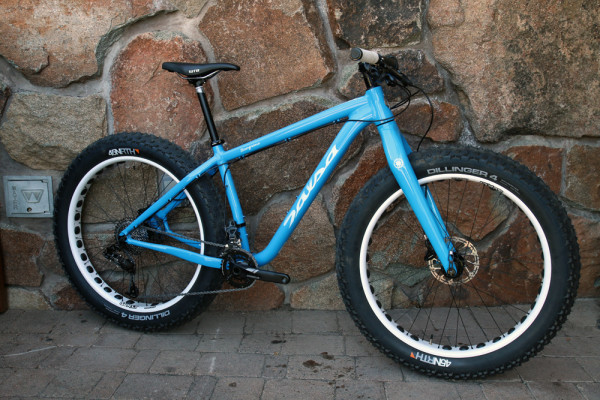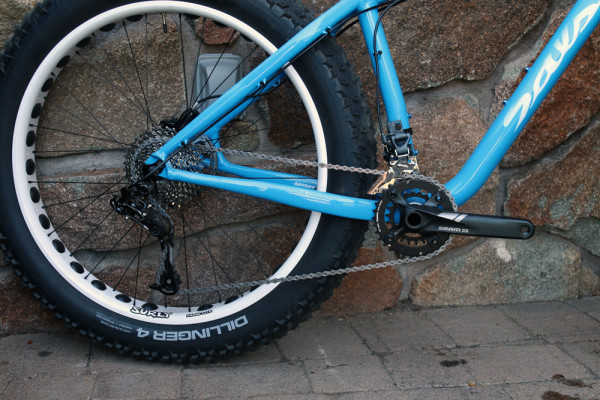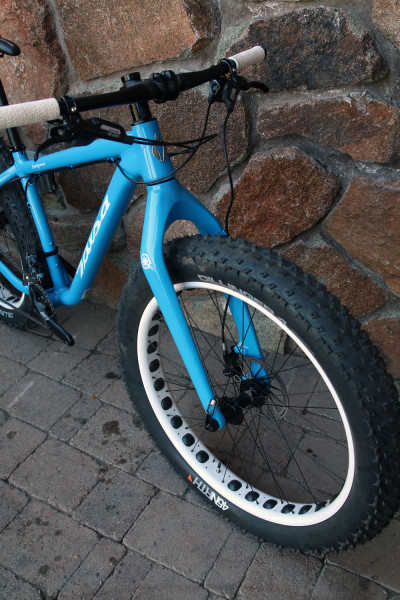You can always tell the hot bike at a demo by how hard it is to get one to try. Whether due to excitement, skepticism, curiosity, or disbelief, usually one bike stands above the rest. In the case of QBP’s Saddle Drive event this year in Ogden UT, that bike had to be the new Salsa Bucksaw full suspension fat bike. It seemed that even those with no interest in fat bikes wanted a ride just to see what it was like.
As the first mass produced full suspension fat bike, the Bucksaw joins other new additions for 2015 to create the most diverse fat bike line up anywhere. While some of the companies are just releasing their first bike with the giant tires, Salsa now offers five different categories of fat bikes from rigid to full sus.
Curious why there needs to be such a variety of fat bikes? Find out next, plus details and actual weights for the Bucksaw, Blackborow, Beargrease, and Mukluk…
After nearly three years of development, the Salsa Bucksaw is finally here. When Salsa first started to think a full suspension fat bike could be a possibility, production fat bike forks didn’t even exist. Initially taking pieces of their Spearfish and Horsethief bikes and creating a prototype, Salsa used Maveric DUC32 and modified Lefty forks to test out the concept. Soon, Salsa started working with Dave Weagle to develop a new suspension platform for Salsa’s 29ers and Dave was instantly on board with the idea of a full suspension fatty. Eventually RockShox decided that they were on board with what we now know as the Bluto, but not before Salsa and Dave had already done most of the engineering for the frame.
Salsa is very keen to point out that this is not a fat Spearfish or Horsethief. Instead it is a purpose built bike, designed from the ground up. One of the most crucial points to the design was characterizing how fat bike tires perform. During the development Dave Weagle designed a rig that would dyno test fat bike tires to catalog how they handled at different PSI, with different width rims, and with different sized tires. This is the reason that the Bucksaw includes 3.8″ tires since the frame’s kinematics are engineered around that size tire on 65-82mm rims.
Designed with trail bike geometry but with 100mm of travel, the Bucksaw uses a 68 degree head tube angle and 444mm chainstays.
Even though the bike was designed around rims up to 82mm wide, the production bikes will ship with the 65mm Marge Lites. Not only do the narrower rims save about a half pound per wheel, the rims create a rounder tire profile that helps to reduce auto-steer. Technically, auto-steer is something found on all bikes which is when turning of the bike creates a lever arm from the contact patch that is off axis from the steering input. Due to narrower tires, auto-steer is usually not noticeable on most bikes. It’s only when you get into the bigger tires of fat bikes that it becomes more noticeable. Auto-steer is also more noticeable at higher speeds which means the Bucksaw is even more susceptible due to its incredible abilities. Considering all of the factors, Surly feels the 65mm rim and 3.8″ tire combination offers the best of both worlds.
The main frame and chainstays on the Bucksaw are made from 6066-T6 aluminum but the frame does use carbon fiber seat stays. Just in the seat stays alone, Salsa was able to save 245g. To match the RockShox Bluto 100mm fork up front, the RockShox Monarch RT3 provides 100mm of travel in the rear.
In order to clear the chainstays, the Bucksaw uses a pressfit 41 121mm wide bottom bracket. This is technically the same width as a 100mm threaded BB and uses the same cranks. A high direct mount front derailleur tab designed for doubles is key to allowing adequate tire clearance but keeping the ability for wider gearing.
No, the frame doesn’t have room for bigger tires. Even 4.0″ tires might be a tight fit, but again this is because the bike is specifically designed around the 3.8″ tire size.
Sold complete with a SRAM X01 build kit and SRAM Guide RS brakes, the Bucksaw 1 also includes a Rockshox Reverb Stealth dropper post. Both of the Bucksaw models use 3.8″ Surly Nate 120tpi tires mounted to Marge Lite 65mm rims with holes and the Salsa 150/177 Fat Conversion hubs. The Bucksaw 1 retails for $4,999 with the frame only coming in at $1,899.
What about the weight? This bike in a 17″ frame came in at 33.9 lbs.
The Bucksaw 2 uses the same suspension components front and rear, but gains a 2×10 SRAM X7/X9 drivetrain with a Type 2 rear derailleur and X5 22/34t crank. SRAM guide R brakes slow the beast down with 180mm rotors front and rear.
The two Bucksaw frames are identical, each with external cable routing with the exception of the derailleur housing through the chainstay and the stealth dropper post routing up the seat tube. Like Salsa’s full suspension 29ers, the Bucksaw features Split Pivot which uses a concentric pivot around the rear axle.
Bucksaw 2s sell for $3,999 and this 19″ frame measured 34.6lbs on our scale.
Another completely new addition to the lineup, the Salsa Blackborow takes adventuring to a new level. Salsa is pretty adamant that everyone doesn’t need 5″ tires. But for those who do, they wanted to design a bike that didn’t cut any corners. Designed around 5″ tires on 100mm wide rims, the Blackborow is what Salsa is referring to as their “Expedition fat bike.” Built to take you deep into the wilderness, Blackborow has a slightly higher bottom bracket and the lowest stand over heights of all Salsa fat bikes.
The harsh, remote back country the Blackborow will bring you to is also the inspiration for one of the two builds. Called the Dinglespeed, the drivetrain arrangement provides essentially two different single speed drivetrains that can be swapped back and forth without adjusting chain tension. In this case you can switch between a 30/18 and a 26/22t gear ratio just by removing the rear axle, dropping the wheel and switching the chain from one gear to the other. Since the front gear gets smaller and the rear cog gets bigger (or vice versa) the chain tension stays the same. The result is a climbing gear and a cruising gear with the durability of a single speed.
The wider tire clearance also means that Salsa went to a wider bottom bracket – this time an offset pressfit 41 shell that is 132mm wide with a 76mm chainline. Salsa says they worked with Surly on this design and is the same that you will find on the Ice Cream Truck. That means the BlackBorow is equipped with the Surly OD crankset which is designed to work with the offset bottom bracket.
Blackborow is designed around their Bearpaw 150 fork, which means the front wheel will be directly compatible with RockShox Bluto suspension forks. The rigid fork uses a 15x150mm axle spacing which we’re told will likely be the industry standard for fat bikes by 2016. Out back the Alternator dropouts use a 197×12 rear thru axle and obviously allow single speed use.
The Dinglespeed Blackborow is painted in Forest Service green which isn’t an accident. In another tie in to the expedition nature of the bike, Salsa painted the frame in the same hue as the Forest Service vehicles like the rad Bronco above.
Dinglespeeds will retail for $2,299 and this 18″ came in at 31.7 lbs.
The geared Blackborow 1 uses the same 6066-T6 aluminum frame and fork but trades the Dingle speed for a 2×10 SRAM x7/x9 Type 2 drivetrain and Surly OD crank. Both Blackborow models use SRAM BB7s brakes, though the 1 gets SRAM Speed Dial 7 levers over the Dinglespeed’s FR5 levers. Salsa Fat Conversion hubs laced to Surly Clown Shoe rims and Surly Lou tires finish off the bike front and rear.
Blackborow 1s will be sold in complete bikes for $2,799 or a frame kit (frame, fork, hubs, and thru axles) for $950. This particular 20″ 1 weighed 33.9 lbs.
While the Mukluk frame hasn’t changed, with the introduction of the RockShox Bluto comes a new line of suspension equipped 4″ fat bikes. The Mukluk 2 uses a SRAM X7/X9 Type 2, 2×10 drivetrain with Surly OD crank and SRAM Guide R brakes. The wheels use Surly Rolling Darryl rims and Surly Nate 3.8″ 120tpi tires to mount in the 150x15mm front, and 170mm QR rear dropouts.
The Mukluk 2 will sell for $2,999 with a sparkly green frame option for $899. Weight for the new aluminum, suspension equipped fat bike was 33.55 lbs for a 17″ frame.
Front suspension also comes to titanium fat bikes in the form of the new Mukluk Ti. The triple butted seamless 3/2.5 titanium frame also uses a 170mm QR rear dropout like the aluminum Mukluk. Compared to the Mukluk 2, the Ti gets upgraded to a SRAM X01/X1 1×11 drivetrain. Due to the Alternator dropouts you can switch to a thru axle rear end, or even build up a new 170mm Rohloff hubs.
If ti fat bikes are you think, you can pick up a Mukluk TI for $4,899 or the frame only for $2,499. The titanium beauty weighs 32.2 lbs for a 19″ frame.
The fully rigid Mukluk 3 will also be available for $1,899.
The last new addition to Salsa’s fat bike gang is the alloy aluminum Beargrease 2. The original Beargrease was aluminum but after the carbon model was introduced the aluminum model was phased out. Well, it’s back with the same frame features as the carbon Beargreases except for the 170mm QR rear end. Up front is a 142x15mm carbon Makwa fork, while the frame is still based around 4″ tires for fat bike speed.
The X7/X9 2×10 equipped bike with SRAM DB5 brakes will retail for $2,599 or $1,499 for the frame and fork. This 17″ frame tipped the scale at 29.19 lbs. In 2015 Beargrease Carbon frames remain unchanged, but will be offered in an XX1 build kit for $5,599 ($2,499 frame and fork) and the Carbon 1 with a SRAM X1 build for $3,699.
